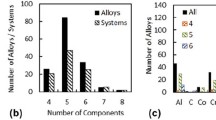Abstract
The constitutive response and deformation mechanisms in refractory metals with a hexagonal close packed (hcp) crystal structure are reviewed. The research focuses on the high-strain-rate stress-strain response under uniaxial compressive loading and the associated microstructural deformation mechanisms. Some aspects relating to dynamic failure such as adiabatic shear banding in refractory metals and subsequent failure processes are also discussed.
Similar content being viewed by others
References
Edward N.C. Dalder, Tony Grobstein, and Charles S. Olsen, ed., Evolution of Refractory Metals and Alloys (Warrendale, PA: TMS, 1993), p. vii.
L.S. Magness and D. Kapoor, “Flow-Softening Tungsten Composites for Kinetic Energy Penetrator Applications,” Proceedings of the Second International Conference on Tungsten and Refractory Metals,ed. Animesh Bose and Robert J. Dowding (Princeton, NJ: MPIF, 1994), pp.11–20.
E.K. Ohriner, V.K. Sikka, and D. Kapoor, “Processing and Properties of Extruded Tungsten-Hafnium and Tungsten-Steel Composites,” Proceedings of the Second International Conference on Tungsten and Refractory Metals, ed. Animesh Bose and Robert J. Dowding (Princeton, NJ: Metal Powder Industries Federation, 1994), pp. 219–226.
D. Edelman, B.J. Pletka, and G. Subhash, “Mechanically Alloying of W-Hf-Ti Alloys,” Proceedings of the Second International Conference on Tungsten and Refractory Metals, ed. Animesh Bose and Robert J. Dowding (Princeton, NJ: Metal Powder Industries Federation, 1994), pp.227–234.
M.A. Meyers et al., Mechanics of Materials, 17 (1994), pp. 175–193.
G. Subhash and G. Ravichandran, “High Strain Rate Behavior and Localization in Hafnium,” Experimental Techniques in the Dynamics of Deformable Solids, ed. K.T. Ramesh, AMD-Vol. 152 (New York: ASME, 1993), pp. 79–84.
G. Subhash and G. Ravichandran, “High Strain Rate Behavior of Localization in Hafnium,” Proceedings of 13th Army Symposium on Solid Mechanics, eds. S.C. Chou et al. (1993), pp. 621–631.
G. Subhash, B.J. Pletka, and G. Ravichandran, “Constitutive Response and Characterization of Deformation modes in Hafnium,” Proceedings of the Second International Conference on Tungsten and Refractory Metals, ed. Animesh Bose and Robert J. Dowding (Princeton, NJ: Metal Powder Industries Federation, 1994), pp.673–680.
G. Ravichandran, Materials and Manufacturing Processes, 9 (6) (1994), pp. 1031–1046.25.
B.J. Koeppel and G. Subhash, “Constitutive Response and Characterization of Deformation Modes in Rhenium,” Proceedings of the Second International Conference on Tungsten and Refractory Metals, ed. Animesh Bose and Robert J. Dowding (Princeton, NJ: Metal Powder Industries Federation, 1994), pp. 673–680.
B.J. Koeppel and G. Subhash, “Plastic Response and Deformation Microstructures in Rhenium,” to appear in the Proceedings of the ASME-Summer Meeting, UCLA (1995).
S. Naka, L.P. Kubin, and C. Perrier, Phil Mag. A, 63(5) (1991), pp. 1035–1043.
V. Vitek, and M. Igarashi, Phil. Mag. A, 63(5) (1991), pp. 1059–1075.
F.D. Rosi, F.C. Perkins, and L.L. Seigle, J. Metals, Trans. AIME (February 1954), pp. 115–122.
F.D. Rosi, J. Metals, Trans. AIME (January 1954), pp. 58–69.
E.D. Levine, Trans. Metall. Soc. AIME, 236, (November, 1966), pp. 1558–1565.
A. Akhtar and A. Teghtsoonian, Acta Metallurgica, 19 (July 1971), pp. 655–663.
G. Das, and T.E. Mitchell, Metall. Trans, 4 (1973), pp. 1405–1413.
T. Hayashi et al., Materials and Manufacturing Processes, 9 (6) (1994), pp. 1047–1060.
Edwin D. Sayre, “Application of Rhenium and Rhenium Containing Alloys,” Evolution of Refractory Metals and Alloys, ed. Edward N.C. Dalder, Tony Grobstein, and Charles S. Olsen (Warrendale, PA: TMS, 1993), pp. 191–200.
B.D. Bryskin, Adv. Mater. & Processes, 142(3) (1992), pp. 22–27.
A.J. Sherman, R.H. Tuffias, and R.B. Kaplan, JOM, 43 (July 1991).
B.D. Bryskin, and F.C. Danek, JOM,43 (July 1991), pp. 24–26.
A. De Crecy et al., Phil. Mag A, 47(2) (1983), pp. 245–254.
F.W. Vahldiek, J. Less. Comm. Metals, 19 (1969), pp. 83–92.
E.J. Rapperport and C.S. Hartley, Trans. of the Met. Soc. of AIME, 218 (October, 1960), pp. 869–877.
G.T. Gray III, C.E. Morris, and A.C. Lawson, “Omega Phase Formation in Titanium and Titanium Alloys,” Titanium '92: Science and Technology, ed. F. Froes and I.L. Caplan (Warrendale, PA: TMS, 1993), pp. 225–232.
M.H. Yoo, C.L. Fu, and J.K. Lee, J. Phys. III, 1 (1991), pp. 1065–1084.
Ch.V. Kopetskiy et al., Phy. of Met. & Metallography, 39(1) (1975), pp. 164–174.
A.T. Churchman, Trans, of the Met. Soc. of AIME, 218 (April, 1960), pp. 262–267.
R.A. Jeffery and E. Smith, Phil. Mag., 8 (1966), pp. 1163–1168.
A. Serra, R.C. Pond, and D.J. Bacon, Acta. Metall. Mater., 39(7) (1991), pp. 1469–1480.
M.H. Yoo and J.K. Lee, Phil. Mag. A, 63(5) (1991), pp. 987–1000.
S.G. Song and G.T. Gray III, Phil. Mag., (1995) to appear.
G.T. Gray III, “Deformation Twinning: Influence of Strain Rate,” Twinning in Advanced Materials, ed. M.H. Yoo and M. Wuttig (Warrendale, PA: TMS, 1994), pp. 337–349.
G.T. Gray III, “Deformation Substructures Induced by High Strain Rate Deformation,” Modelling the Deformation of Crystalline Solids, ed. Terry C. Lowe et al, (Warrendale, PA: TMS, 1991), pp. 145–158.
M. Griffiths, Phil. Mag. A, 63(5) (1991), pp. 835–847.
Author information
Authors and Affiliations
Rights and permissions
About this article
Cite this article
Subhash, G. The constitutive behavior of refractory metals as a function of strain rate. JOM 47, 55–58 (1995). https://doi.org/10.1007/BF03221179
Issue Date:
DOI: https://doi.org/10.1007/BF03221179




